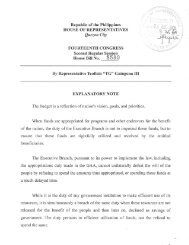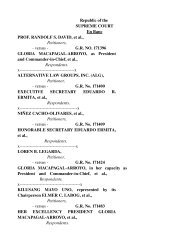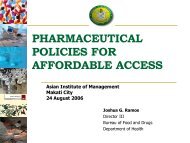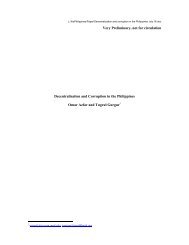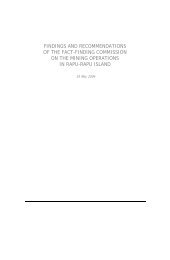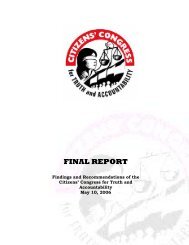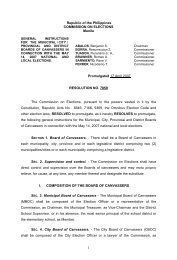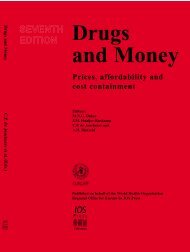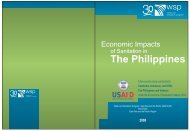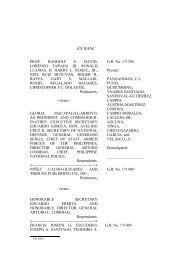The state of water resources in the Philippines - Greenpeace
The state of water resources in the Philippines - Greenpeace
The state of water resources in the Philippines - Greenpeace
Create successful ePaper yourself
Turn your PDF publications into a flip-book with our unique Google optimized e-Paper software.
III. Status <strong>of</strong> <strong>water</strong> use and supply<br />
<strong>The</strong> Department <strong>of</strong> Science and Technology, through its Integrated Program on<br />
Cleaner Production Technologies, encourages <strong>the</strong> adoption <strong>of</strong> clean technologies<br />
by provid<strong>in</strong>g support mechanisms for <strong>the</strong> <strong>in</strong>dustrial sector for <strong>the</strong> identification,<br />
evaluation, selection, and acquisition <strong>of</strong> cost-effective technologies for cleaner<br />
production.<br />
Part <strong>of</strong> government’s response to <strong>the</strong> problem is <strong>the</strong> formulation <strong>of</strong> various<br />
policies, monitor<strong>in</strong>g and analysis, researches, and capacity build<strong>in</strong>g among key<br />
stakeholders as part <strong>of</strong> <strong>the</strong>ir regular functions, and through <strong>the</strong> different programs<br />
implemented by concerned agencies.<br />
Alternatives to conventional sewage treatment are now be<strong>in</strong>g <strong>in</strong>troduced.<br />
Wetlands are be<strong>in</strong>g designed to serve as simple and low-cost waste<strong>water</strong><br />
treatment plants that use natural processes for filtration and clean<strong>in</strong>g. Partially<br />
treated sewage can also be used for fish propagation (EMB, 2006).<br />
(While this <strong>in</strong>expensive, low-ma<strong>in</strong>tenance technology is reportedly <strong>in</strong> high<br />
demand <strong>in</strong> Central America, Eastern Europe, and Asia. However, <strong>in</strong> <strong>the</strong> United<br />
States, treatment-wetland technology has not yet ga<strong>in</strong>ed national regulatory<br />
acceptance (Cole, Stephen; “Emergence <strong>of</strong> Treatment Wetlands”, 1998).<br />
In part, this reluctance exists because <strong>the</strong> technology is not yet completely<br />
understood. Knowledge <strong>of</strong> how <strong>the</strong> wetland works is not far enough advanced to<br />
provide eng<strong>in</strong>eers with detailed predictive models. And, be<strong>in</strong>g natural systems,<br />
<strong>the</strong>ir performance is variable, subject to <strong>the</strong> vagaries <strong>of</strong> chang<strong>in</strong>g seasons and<br />
vegetative cycles. <strong>The</strong>se treatment wetlands also pose a potential threat to<br />
wildlife attracted to this new habitat--an ecosystem exposed to toxic compounds<br />
(Cole, S, 1998).<br />
(Ano<strong>the</strong>r concern expressed by some experts is <strong>the</strong> nitrogen removal process, as<br />
this is considered a serious drawback <strong>in</strong> us<strong>in</strong>g constructed wetlands for<br />
waste<strong>water</strong> treatment (Simons, J., 2000).)<br />
A. Lead<strong>in</strong>g consumers or users <strong>of</strong> <strong>water</strong><br />
<strong>The</strong> country’s major <strong>water</strong> users are <strong>the</strong> agricultural sector which accounts for<br />
85.27 percent <strong>of</strong> <strong>the</strong> total <strong>water</strong> supply, <strong>the</strong> <strong>in</strong>dustrial sector which consumes<br />
7.46% and lastly <strong>the</strong> domestic users which use <strong>the</strong> rema<strong>in</strong><strong>in</strong>g 7.27percent (PEM,<br />
2003; 2004).<br />
In <strong>the</strong> Philipp<strong>in</strong>es, agriculture as a whole is <strong>the</strong> greatest consumer <strong>of</strong> <strong>water</strong>.<br />
Irrigation constitutes a large portion <strong>of</strong> total <strong>water</strong> consumption by agriculture; it is<br />
considered <strong>the</strong> biggest <strong>water</strong> user <strong>in</strong> <strong>the</strong> country, notwithstand<strong>in</strong>g <strong>the</strong> fact that<br />
only 47 percent <strong>of</strong> <strong>the</strong> potentially irrigable area <strong>of</strong> 3.16 million hectares is<br />
irrigated. About 95 percent <strong>of</strong> <strong>the</strong> irrigated area is devoted to paddy and about 70<br />
percent <strong>of</strong> paddy production comes from irrigated lands (Dayrit, H., <strong>The</strong><br />
Philipp<strong>in</strong>es: Formulation <strong>of</strong> a <strong>water</strong> vision, NWRB).<br />
GREENPEACE | <strong>The</strong> <strong>state</strong> <strong>of</strong> <strong>water</strong> <strong>in</strong> <strong>the</strong> Philipp<strong>in</strong>es 26



